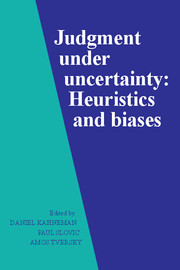Book contents
- Frontmatter
- Contents
- List of contributors
- Preface
- Part I Introduction
- Part II Representativeness
- Part III Causality and attribution
- Part IV Availability
- Part V Covariation and control
- Part VI Overconfidence
- Part VII Multistage evaluation
- 24 Evaluation of compound probabilities in sequential choice
- 25 Conservatism in human information processing
- 26 The best-guess hypothesis in multistage inference
- 27 Inferences of personal characteristics on the basis of information retrieved from one's memory
- Part VIII Corrective procedures
- Part IX Risk perception
- Part X Postscript
- References
- Index
24 - Evaluation of compound probabilities in sequential choice
Published online by Cambridge University Press: 05 May 2013
- Frontmatter
- Contents
- List of contributors
- Preface
- Part I Introduction
- Part II Representativeness
- Part III Causality and attribution
- Part IV Availability
- Part V Covariation and control
- Part VI Overconfidence
- Part VII Multistage evaluation
- 24 Evaluation of compound probabilities in sequential choice
- 25 Conservatism in human information processing
- 26 The best-guess hypothesis in multistage inference
- 27 Inferences of personal characteristics on the basis of information retrieved from one's memory
- Part VIII Corrective procedures
- Part IX Risk perception
- Part X Postscript
- References
- Index
Summary
Situations frequently occur in which a successful outcome depends on an individual making a correct choice at each of several more or less independent stages. The choice of mode of transport at various stages of a journey is one example. Comparable predicaments occur in professional, administrative, political and military life, and in communication networks generally. The temporal order of the several choices is not invariably a vital factor. Furthermore, the situation as a whole may have a stochastic character in that the probability of correct choice may vary from stage to stage.
We shall describe an experiment simulating this general type of situation, which clearly requires, for a successful outcome, the multiplication of probabilities. Studies of preference for locating a target in an m × n array, or in a display partitioned into concentric zones, indicate that the cells in the array or the concentric zones are not subjectively equiprobable as locations for the target (Cohen, Boyle, & Chesnick, 1969). Subjects do not seem to guess, at random, the unknown location of the target. Their strategy of search rather has the character of “divining” where the experimenter has hidden it, or of locating it where they would expect it to be. Other experiments (Cohen & Hansel, 1958) suggest that many people, when faced with a situation involving compound probabilities, tend to add, instead of multiply, the chances at the different stages.
- Type
- Chapter
- Information
- Judgment under UncertaintyHeuristics and Biases, pp. 355 - 358Publisher: Cambridge University PressPrint publication year: 1982
- 3
- Cited by

